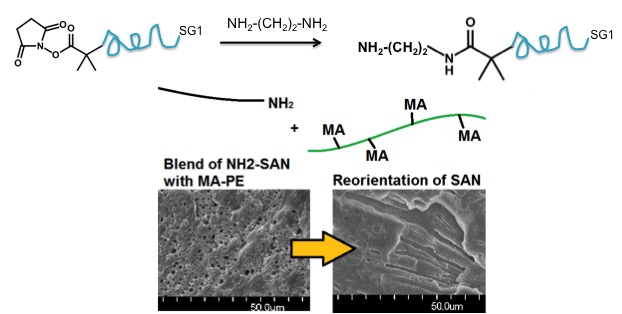NMP for Barrier Polymers in Poly(ethylene)
This project applies reactive polymer blending to produce value-added poly(ethylene) containing products for barrier applications. This approach has been widely applied in the literature but is generally limited to the types of polymers that can be used. For example, nylon is compounded as elongated structures into poly(ethylene) for gas tanks to prevent swelling of the poly(ethylene). Such morphologies of nylon within the poly(ethylene) matrix are stabilized by reactive blending between the amino groups inherent in the nylon and complementary functional groups like maleic anhydride that can be readily grafted onto poly(ethylene). The resulting copolymer formed in situ at the interface prevents coalescence of the dispersed phase during subsequent processing such as injection molding or rotational molding. However, such an approach is limited to commercially available polymers with the inherent functionality. In many applications, it is desirable to incorporate other barrier polymers for which the functional group is not a residue of the original polymerization process and to have functional groups sequestered at a specific part of the chain. This proposal aims to impart this tailored functionality via controlled radical polymerization (CRP), in particular primary amine or carboxylic acid-containing polymers based on styrene-acrylonitrile copolymers (SAN), which are noted for excellent grease resistance and gas barrier properties. CRP is attractive because it superficially mimics many attractive features of “living” polymerizations such as tight control of molecular weight distribution and placement of functional groups but is easily adaptable to conventional free radical processes and does not require functional group protection or excessively air-free transfers. The resulting functional barrier copolymers were melt blended with suitably functionalized poly(ethylene) initially in a miniature twin-screw extruder and morphology was studied as a function of composition, type of reaction and processing conditions.
Reactive blending of amino-functionalized SAN into maleic anhydride functionalized poly(ethylene). Note the finely dispersed SAN domains that were re-oriented into elongated domains (adapted from Oxby, K. J.; Marić, M. “Compatibilization of Poly(styrene-acrylonitrile) (SAN)/ Poly(ethylene) Blends via Amine Functionalization of SAN Chain Ends” React. Eng. 2014, 8, 160-169. (cover article)
